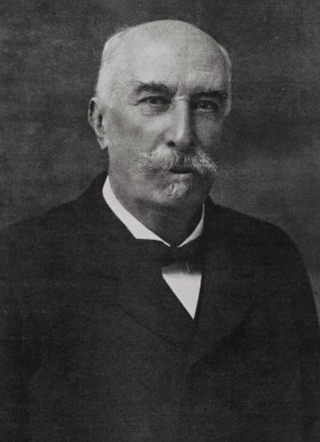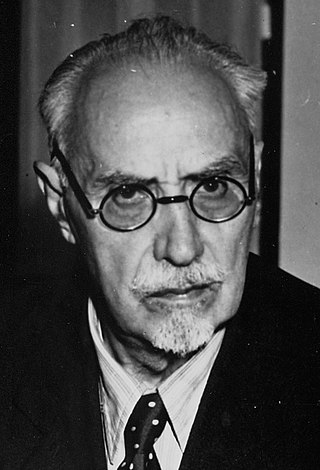
Giovanni Giolitti was an Italian statesman. He was the Prime Minister of Italy five times between 1892 and 1921. After Benito Mussolini, he is the second-longest serving Prime Minister in Italian history. A prominent leader of the Historical Left and the Liberal Union, he is widely considered one of the most powerful and important politicians in Italian history; due to his dominant position in Italian politics, Giolitti was accused by critics of being an authoritarian leader and a parliamentary dictator.

The March on Rome was an organized mass demonstration and a coup d'état in October 1922 which resulted in Benito Mussolini's National Fascist Party (PNF) ascending to power in the Kingdom of Italy. In late October 1922, Fascist Party leaders planned an insurrection to take place by marching on the capital. On 28 October, the fascist demonstrators and Blackshirt paramilitaries approached Rome; Prime Minister Luigi Facta wished to declare a state of siege, but this was overruled by King Victor Emmanuel III, who, fearing bloodshed, persuaded Facta to resign by threatening to abdicate. On 30 October 1922, the King appointed Mussolini as Prime Minister, thereby transferring political power to the fascists without armed conflict. On 31 October the fascist Blackshirts paraded in Rome, while Mussolini formed his coalition government.

Ivanoe Bonomi[iˈvaːnoe boˈnɔːmi] was an Italian politician and journalist who served as Prime Minister of Italy from 1921 to 1922 and again from 1944 to 1945.

The Italian Socialist Party was a social-democratic and democratic-socialist political party in Italy, whose history stretched for longer than a century, making it one of the longest-living parties of the country. Founded in Genoa in 1892, the PSI was from the beginning a big tent of Italy's political left and socialism, ranging from the revolutionary socialism of Andrea Costa to the Marxist-inspired reformist socialism of Filippo Turati and the anarchism of Anna Kuliscioff. Under Turati's leadership, the party was a frequent ally of the Italian Republican Party and the Italian Radical Party at the parliamentary level, while lately entering in dialogue with the remnants of the Historical Left and the Liberal Union during Giovanni Giolitti's governments to ensure representation for the labour movement and the working class. In the 1900s and 1910s, the PSI achieved significant electoral success, becoming Italy's first party in 1919 and during the country's Biennio Rosso in 1921, when it was victim of violent paramilitary activities from the far right, and was not able to move the country in the revolutionary direction it wanted.

The Biennio Rosso was a two-year period, between 1919 and 1920, of intense social conflict in Italy, following the First World War. The revolutionary period was followed by the violent reaction of the fascist blackshirts militia and eventually by the March on Rome of Benito Mussolini in 1922.

San Giovanni in Persiceto is a town and comune in the Metropolitan City of Bologna, northern Italy.

Filippo Turati was an Italian sociologist, criminologist, poet and socialist politician.

The Fasci Italiani di Combattimento was an Italian fascist organisation created by Benito Mussolini in 1919. It was the successor of the Fascio d'Azione Rivoluzionaria, being notably further right than its predecessor. The Fasci Italiani di Combattimento was reorganised into the National Fascist Party in 1921.

General elections were held in Italy on 16 November 1919. The fragmented Liberal governing coalition lost the absolute majority in the Chamber of Deputies, due to the success of the Italian Socialist Party and the Italian People's Party.
Occupation of factories is a method of the workers' movement used to prevent lock outs. They may sometimes lead to "recovered factories", in which the workers self-manage the factories.
Italian anarchism as a movement began primarily from the influence of Mikhail Bakunin, Giuseppe Fanelli, and Errico Malatesta. Rooted in collectivist anarchism and social anarchism, it expanded to include illegalist individualist anarchism, mutualism, anarcho-syndicalism, and especially anarcho-communism. In fact, anarcho-communism first fully formed into its modern strain within the Italian section of the First International. Italian anarchism and anarchists participated in the biennio rosso and survived Italian Fascism. Platformism and insurrectionary anarchism were particularly common in Italian anarchism and continue to influence the movement today. The synthesist Italian Anarchist Federation appeared after the war, and autonomismo and operaismo especially influenced Italian anarchism in the second half of the 20th century.

The Kingdom of Italy witnessed significant widespread civil unrest and political strife in the aftermath of World War I and the rise of the Far-right Fascist movement led by Benito Mussolini which opposed the rise of the international left, especially the far-left along with others who opposed Fascism.
Events from the year 1922 in Italy.
The Italian Anarchist Communist Union, or Italian Anarchist Union, was an Italian political organization founded in Florence in 1919. It played an important role during the unrest of the Red Biennium, before it was suppressed by the fascist regime in 1926.

The Revolutions of 1917–1923 were a revolutionary wave that included political unrest and armed revolts around the world inspired by the success of the Russian Revolution and the disorder created by the aftermath of World War I. The uprisings were mainly socialist or anti-colonial in nature. Some socialist revolts failed to create lasting socialist states. The revolutions had lasting effects in shaping the future European political landscape, with for example the collapse of the German Empire and the dissolution of Austria-Hungary.

Pietro Ferrero was an Italian anarchist and trade unionist.
Events from the year 1921 in Italy.
Socialism in Italy is a political movement that developed during the Industrial Revolution over a course of 120 years, which came to a head during the Revolutions of 1848. At the beginning of the 20th century, there were a growing number of social changes. The outbreak of the First World War accelerated economic differentiation causing a wider wealth gap. This is seen as one of the key factors that triggered the emergence of Italian socialism.

The Red Guards, also known as Proletarian Defense Formations, were a paramilitary organization affiliated with the Italian Socialist Party (PSI) and later the Communist Party of Italy (PCdI) during the Red Biennium of the Kingdom of Italy.
The term Bocci-bocci is an Italian linguistic corruption of the word Bolshevism, meaning to "Break everything", used particularly in Florence and Tuscany during the Biennio Rosso, in which there was a number of mass strikes against high costs of living, self-management experiments towards autarky through land and factory occupation, and in Turin and Milan, workers councils were formed with factory occupation under the leadership of anarcho-syndicalists.
















